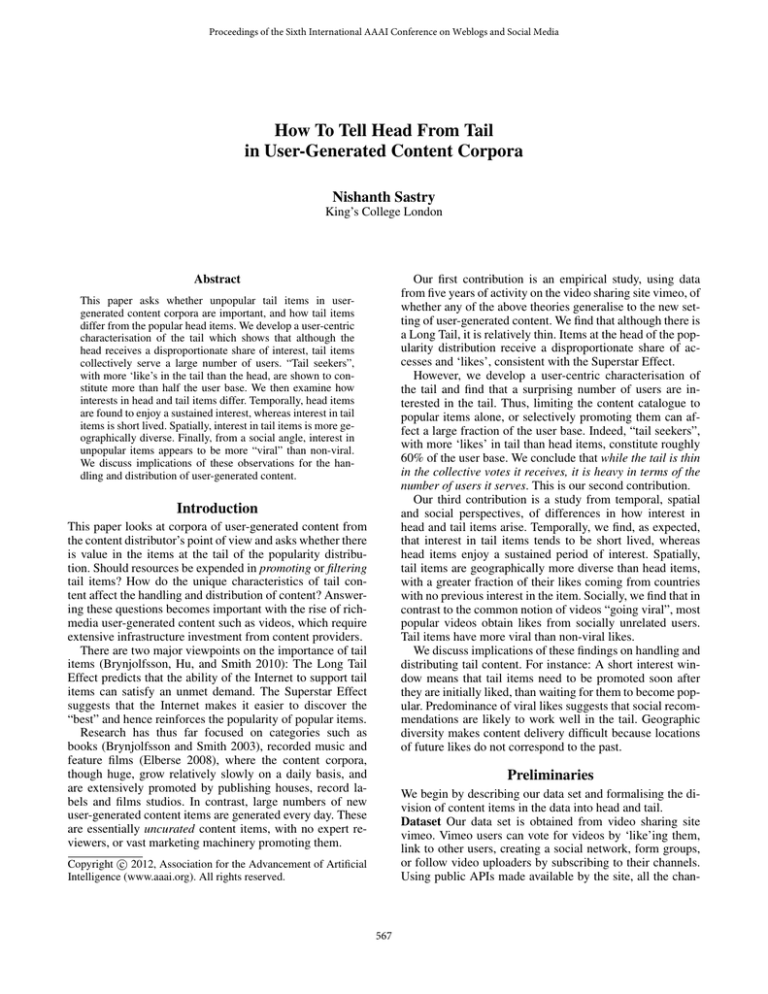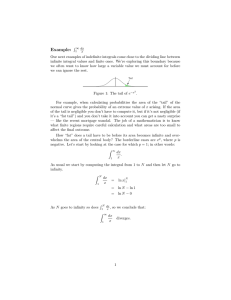
Proceedings of the Sixth International AAAI Conference on Weblogs and Social Media
How To Tell Head From Tail
in User-Generated Content Corpora
Nishanth Sastry
King’s College London
Abstract
Our first contribution is an empirical study, using data
from five years of activity on the video sharing site vimeo, of
whether any of the above theories generalise to the new setting of user-generated content. We find that although there is
a Long Tail, it is relatively thin. Items at the head of the popularity distribution receive a disproportionate share of accesses and ‘likes’, consistent with the Superstar Effect.
However, we develop a user-centric characterisation of
the tail and find that a surprising number of users are interested in the tail. Thus, limiting the content catalogue to
popular items alone, or selectively promoting them can affect a large fraction of the user base. Indeed, “tail seekers”,
with more ‘likes’ in tail than head items, constitute roughly
60% of the user base. We conclude that while the tail is thin
in the collective votes it receives, it is heavy in terms of the
number of users it serves. This is our second contribution.
Our third contribution is a study from temporal, spatial
and social perspectives, of differences in how interest in
head and tail items arise. Temporally, we find, as expected,
that interest in tail items tends to be short lived, whereas
head items enjoy a sustained period of interest. Spatially,
tail items are geographically more diverse than head items,
with a greater fraction of their likes coming from countries
with no previous interest in the item. Socially, we find that in
contrast to the common notion of videos “going viral”, most
popular videos obtain likes from socially unrelated users.
Tail items have more viral than non-viral likes.
We discuss implications of these findings on handling and
distributing tail content. For instance: A short interest window means that tail items need to be promoted soon after
they are initially liked, than waiting for them to become popular. Predominance of viral likes suggests that social recommendations are likely to work well in the tail. Geographic
diversity makes content delivery difficult because locations
of future likes do not correspond to the past.
This paper asks whether unpopular tail items in usergenerated content corpora are important, and how tail items
differ from the popular head items. We develop a user-centric
characterisation of the tail which shows that although the
head receives a disproportionate share of interest, tail items
collectively serve a large number of users. “Tail seekers”,
with more ‘like’s in the tail than the head, are shown to constitute more than half the user base. We then examine how
interests in head and tail items differ. Temporally, head items
are found to enjoy a sustained interest, whereas interest in tail
items is short lived. Spatially, interest in tail items is more geographically diverse. Finally, from a social angle, interest in
unpopular items appears to be more “viral” than non-viral.
We discuss implications of these observations for the handling and distribution of user-generated content.
Introduction
This paper looks at corpora of user-generated content from
the content distributor’s point of view and asks whether there
is value in the items at the tail of the popularity distribution. Should resources be expended in promoting or filtering
tail items? How do the unique characteristics of tail content affect the handling and distribution of content? Answering these questions becomes important with the rise of richmedia user-generated content such as videos, which require
extensive infrastructure investment from content providers.
There are two major viewpoints on the importance of tail
items (Brynjolfsson, Hu, and Smith 2010): The Long Tail
Effect predicts that the ability of the Internet to support tail
items can satisfy an unmet demand. The Superstar Effect
suggests that the Internet makes it easier to discover the
“best” and hence reinforces the popularity of popular items.
Research has thus far focused on categories such as
books (Brynjolfsson and Smith 2003), recorded music and
feature films (Elberse 2008), where the content corpora,
though huge, grow relatively slowly on a daily basis, and
are extensively promoted by publishing houses, record labels and films studios. In contrast, large numbers of new
user-generated content items are generated every day. These
are essentially uncurated content items, with no expert reviewers, or vast marketing machinery promoting them.
Preliminaries
We begin by describing our data set and formalising the division of content items in the data into head and tail.
Dataset Our data set is obtained from video sharing site
vimeo. Vimeo users can vote for videos by ‘like’ing them,
link to other users, creating a social network, form groups,
or follow video uploaders by subscribing to their channels.
Using public APIs made available by the site, all the chan-
c 2012, Association for the Advancement of Artificial
Copyright Intelligence (www.aaai.org). All rights reserved.
567
To test this, we look at the fraction of accesses that would
be satisfied if only the top videos (by likes or plays) are
available to consumers. The distributions for both are similar
(Fig. 1a): we see a familiar 80-20 split, with the least popular 80% of videos only contributing ≈20% of plays or likes.
Thus, in terms of likes or plays, the tail is long but relatively
thin, consistent with the “Superstar” argument.
nels and groups on the site were first crawled, obtaining information about users who are subscribers or members, and
videos of the channels and groups. From here, additional
video and user objects were obtained by snowball sampling,
using links between users to obtain further users and videos.
The vimeo data comprises five years of activity, from Feb
16, 2005 (within 3 months of when vimeo was founded) up
to Mar 27, 2010. Some statistics are summarised below.
Video statistics
Videos 443,653
Likes 2,427,802
A user-centric characterisation of the tail Because the
Superstar Effect predicts a rich-gets-richer self-reinforcment
of item popularity, (Elberse 2008) recommends that firms
should not invest in tail items but continue to focus on the
few expected “hits”. We can apply this to user-generated
content by limiting the catalogue to the most popular items,
or highlighting them (e.g. by featuring in leader boards such
as “Most Popular Videos”).
However, Fig. 1a also shows that in terms of users, the tail
is extremely important. More than 80% of videos need to be
included to satisfy 80% of the user base. In other words,
most of the users have some interest in the tail. We probe
deeper, asking what fraction of user likes are in the tail. This
maps the density of tail likes for users (Fig. 1b). Nearly half
the users have 60% or more of their likes in the tail.Just under 30% of users have all their likes in the tail.
Together, these results imply that from a user-centric point
of view, the tail is extremely important. Although the popular few items at the head receive a disproportionate number of likes, a large number of users have some interest in
the unpopular majority of tail items. This is unexpected. Indeed, McPhee’s theory of exposure (McPhee 1963), which
(Elberse 2008) invoked in explaining the Superstar Effect
predicts exactly the opposite based on two effects:
Natural monopoly: The items in the head enjoy a natural monopoly over light users, because they would not have
heard of the more obscure tail items.
Double jeopardy Tail items are less well known. Further,
they are less likely to be appreciated by those who know.
In McPhee’s theory, these two effects give rise to a head
in which a majority of users, both heavy and light, are interested, and a tail in which not many are interested. This
explains the popularity of “hits” and the “Superstar effect”.
We find that neither natural monopoly nor double jeopardy hold in the user-generated videos of our dataset. To
show this, we first divide users into “tail seekers”, users who
like more items in the tail than in the head, and “head seekers”, who like more head items than tail items.
By definition, head items have a “natural monopoly” over
head seekers. If McPhee’s theory holds, head seekers should
be light users, with fewer likes per capita. Instead, we find
that head seekers have a median of 8 likes (mean=25.07) per
user, whereas tail seekers are lighter users with a median of 4
likes (mean=22.52). Fig. 1c shows that even in distribution,
tail seekers have comparatively fewer likes per capita.
Further, we find that there are slightly more (≈60%) tail
seekers than head seekers. This negates the double jeopardy
prediction, which holds that fewer users would be familiar
with or appreciate obscure tail items.
Summary: The characterisation which emerges is of a
head and tail enjoyed by nearly equal numbers of users.
Social graph statistics
Users 207,468
Directed links 718,457
Defining the head (popular) & tail (unpopular)
Unlike traditional items such as books and movies, usergenerated content does not have an alternate physical distribution channel. Thus we cannot easily pick an absolute
number (the inventory size of the “brick-and-mortar” stores)
to define the head. Picking a fixed percentage (say x%) of
the total number of videos also becomes equally arbitrary.
Therefore, in this paper, we define the head (popular) items
as items whose consumption counts are at least one standard
deviation above the mean consumption. Items with a smaller
consumption count belong to the (unpopular) tail.
How important is the tail?
This section characterises the importance of items in the tail
relative to the popular head items. Following (Elberse 2008),
we examine two theories, the Long Tail Effect and Superstar
Effect, which predict contradictory outcomes. We examine
our data to see which of these applies in the case of usergenerated content, and explain discrepancies found.
The Long Tail vs the Superstar Effect At the risk of over
simplification, there are two main viewpoints on whether tail
items merit attention (Brynjolfsson, Hu, and Smith 2010).
The first view, popularised as the “Long Tail effect” by Chris
Anderson (Anderson 2006), is based on the observation that
unlike physical “brick-and-mortar” retailers which are limited by building sizes and the cost involved in stocking and
distributing to a geographically diverse set of stores, online
retailers can offer a much larger catalogue, including socalled tail items whose individual sales are low enough to
be cost ineffective for brick-and-mortar retailers. One of the
earliest works in this area (Brynjolfsson and Smith 2003)
examined Amazon book sales and showed that the tail items
contribute to a significant fraction of Amazon’s total sales.
The second view, dubbed the “Superstar” effect, draws on
the economics of Superstars (Rosen 1981), and posits that
since the Internet makes it easier for consumers to discover
the true hits (the superstars), and for these items to be delivered to the consumers wherever they are geographically,
popular products can become disproportionately profitable
over time (Elberse and Oberholzer-Gee 2006).
The two theories can be tested in terms of the measurable predictions they make: The Long Tail Effect posits that
the share of the tail in the online world could be significant,
whereas the Superstar Effect places most of the mass of the
popularity distribution in the head items.
568
(a)
(b)
(c)
Figure 1: (a) The tail is heavy in users. If the tail is defined in terms of number of accesses (plays or likes), the familiar 80-20
rule is obtained with the top 20% of videos satisfying 80% of plays or likes. However, when we look at the fraction of users
all of whose likes would be fulfilled by the top x% of videos, more than 80% of videos need to be included to satisfy 80% of
the user base. (b) Likes sets of many users are dense in tail items u% of users have a fraction of f or more of their likes in
the tail. (c) Tail seekers are lighter users The Cumulative Distribution Function (CDF) of the number of likes of tail seekers
remains above that of head seekers, indicating that tail seekers are comparatively light users with fewer likes per user.
However, the head as we have defined it constitutes a mere
1.5% of videos. Thus, head items typically obtain more likes
than tail items, explaining the thin tail in terms of likes.
Figs. 1a–1b show that user interest extends far into the tail.
Thus, this picture is robust to other choices for the stopping
point of the head and beginning of the tail.
on the top countries can be useful. For instance, non-specific
advertising could focus on ads relevant to the top countries.
However, on the level of individual videos, tail and head
items behave differently. We define geographic diversity as
the ratio of the number of distinct countries from which
the likes of a video originate, to the total number of its
likes. Fig. 2b shows that unpopular videos are more geographically diverse than popular ones. It means that the geographic profile of previous users may not be revealing of
future users. This makes it costlier to distribute content such
as streaming videos, which need to be replicated close to
viewers. It can also cause difficulties for targeted advertising. It can also cause difficulties for targeted advertising.
How does the head differ from the tail?
Having established that the tail items are important to the
user base, we next identify temporal, spatial and social characteristics in which the tail differs from the head, and study
how they can be useful to content providers and distributors.
Temporal perspective: tail items are short lived As corpora of user-generated content continue to grow rapidly, it
is natural to ask what is the effective catalogue size. Do old
items continue to be relevant, or are new ones more important? This can be captured as the interest windows of items
(time of last ‘like’ minus time of first ‘like’). Fig. 2a shows,
not unexpectedly, that popular stories get accessed over a
much longer time window than unpopular stories.Thus, popular stories can see a sustained period of interest. In contrast,
tail items enjoy only a brief surge of interest.
Based on these results, content providers can decide, for
example, to offload only recent items to an expensive content
delivery network, or replicate them more widely by other
means. Similarly, search results could be made more relevant by attaching greater importance to new tail items, and
tail items should be promoted before their interest window
expires, rather than waiting for them to become popular.
Social perspective: Impact of viral accesses We next examine how the social network impacts on the popularity. Inspired by theories of viral propagation of awareness about
stories, products, etc. that have become prominent recently
(e.g. (Gladwell 2002)), we tested the hypothesis that the stories which become popular are the ones that spread successfully within the social network.
Our definitions of viral and non-viral accesses are adopted
as follows. If an item is liked by a user after a direct friend on
the social network has liked it, we term the access as viral.
In contrast, if no direct friend has liked the item, then the
access is termed as non-viral.
Fig. 2c bins videos in the Vimeo trace by the ratio of viral to non-viral likes (rounded to one decimal place). It then
measures the number of popular stories. It can be seen that
as the ratio of viral to non-viral likes increases, the number of popular stories falls drastically. We conjecture that
while there may be individual successes of “viral marketing”
strategies, in general, a story which spreads mainly by viral
propagation remains localised to one part of the social network. Whereas, an inherently popular story is independently
(non-virally) liked in several parts of the social network.
Clearly the ratio of viral to non-viral accesses can be used
for multiple purposes, including popularity prediction, as
above. Other uses include social recommendations for tail
items, which is likely to be more successful when the fraction of viral likes is high.
Spatial perspective: The geographically diverse tail
Next, we examine where the likes of each video come from.
In Vimeo, each user can enter an arbitrary string description of their location. We use Google and Yahoo geocoding
APIs to first map these strings to a latitude-longitude pair,
and then obtain the country of the user. We then examine the
countries from which ’likes’ for videos arise.
Although there are users from 174 countries, one country, United States, accounts for ≈20% of all likes. The top
two countries (US and UK) together account for 31%. This
skewed usage suggests that overall, a strategy of focusing
569
(a)
(b)
(c)
Figure 2: (a) Popular items have sustained period of interest: CDF of time window of interest shows that unpopular items
have briefer windows of interest than popular items. (b) Interest in unpopular items is geographically diverse: Geographic
diversity ratio measures the fraction of likes of an item that come from a new country. The CDF of this value for popular
and unpopular videos is shown. Unpopular videos have a much larger fraction of their likes drawn from a different country.
(c) Non-viral accesses predominate in popular stories: x-axis shows the ratio of number of viral to non-viral likes. Y axis
shows the number of popular stories that have the corresponding ratio. Most popular stories have a low viral to non-viral ratio.
Related Work
References
A number of studies (Gill and others 2007; Cheng, Dale,
and Liu 2008; Cha and others 2009) have looked at various properties of YouTube videos. However, they do not focus on the tail items, which is our goal. Further, although
a few studies have looked at the relative popularity of tail
items in Video on Demand (Yu and others 2006), and podcasts (Gunawardena and others 2009), very few have developed a user-centric notion of the long tail. (Goel and others.
2010) explores the nature of the tail of user preferences and
finds that in non user-generated (curated) content corpora
such as movies and music, most users have an interest in and
consume items from the tail. Here, we precisely characterise
this interest in terms of user density in the tail, and also show
that this generalises to new setting of user-generated videos.
Studies of information propagation in Flickr (Cha, Mislove, and Gummadi 2009) and Amazon (Leskovec, Adamic,
and Huberman 2007) find evidence that purely viral propagation is largely ineffective. (Lerman and Ghosh 2010) examines the spread of information in digg and twitter and find
a predominance of viral accesses similar to us. Our novelty
is in identifying differences in viral/non-viral ‘like’ ratios
between head and tail, and suggesting ways to exploit this.
Anderson, C. 2006. The Long Tail: Why the future of business is
selling less of more. Hyperion Books.
Brynjolfsson, E., and Smith, M. 2003. Consumer surplus in the
digital economy: Estimating the value of increased product variety
at online booksellers. Management Science 49(11):1580–1596.
Brynjolfsson, E.; Hu, Y.; and Smith, M. 2010. Research
commentary—long tails vs. superstars: The effect of information
technology on product variety and sales concentration patterns. Information Systems Research 21(4):736–747.
Cha, M., et al. 2009. Analyzing the video popularity characteristics
of large-scale user generated content systems. IEEE/ACM Trans.
Networking 17(5):1357–1370.
Cha, M.; Mislove, A.; and Gummadi, K. P. 2009. A measurementdriven analysis of information propagation in the flickr social network. In Proc. WWW ’09.
Cheng, X.; Dale, C.; and Liu, J. 2008. Statistics and social network
of youtube videos. In IWQoS 2008, 229–238. IEEE.
Elberse, A., and Oberholzer-Gee, F. 2006. Superstars and underdogs: An examination of the long tail phenomenon in video sales.
Division of Research, Harvard Business School.
Elberse, A. 2008. Should you invest in the long tail. Harvard
Business Review 86(7/8):88–96.
Gill, P., et al. 2007. Youtube traffic characterization: a view from
the edge. In Proc. SIGCOMM Internet Measurement Conf. (IMC).
Gladwell, M. 2002. Tipping Point. Back Bay Books.
Goel, S., and others. 2010. Anatomy of the long tail: ordinary
people with extraordinary tastes. In Proc. WSDM.
Gunawardena, D., et al. 2009. Characterizing podcast services:
publishing, usage, and dissemination. In Proc. SIGCOMM IMC.
Lerman, K., and Ghosh, R. 2010. Information contagion: An empirical study of the spread of news on digg and twitter social networks. In Proc. ICWSM.
Leskovec, J.; Adamic, L. A.; and Huberman, B. A. 2007. The
dynamics of viral marketing. ACM Trans. Web 1(1):5.
McPhee, W. 1963. Formal theories of mass behavior. Free Press
of Glencoe New York.
Rosen, S. 1981. The economics of superstars. The American
Economic Review 71(5):845–858.
Yu, H., et al. 2006. Understanding user behavior in large-scale
video-on-demand systems. Oper. Syst. Rev. 40(4):333–344.
Summary
Examining user-generated videos shared over five years on
vimeo.com, this paper first showed that although the head receives a majority of ‘like’s, user interest extends far into the
tail, with many users being “tail seekers” with more ‘like’s
in the tail than the head. Thus, from a user-centric point of
view, it is important to effectively distribute and promote tail
items. We then discussed factors which help or hinder this:
Tail items have a small time window of interest, which helps
dramatially reduce numbers. However, interest in the tail is
also spatially diverse, which complicates delivery of content
such as streaming videos. Finally, likes for tail items are predominantly “viral” which suggests use of techniques such as
social recommendations to highlight interesting videos.
We have observed similar results (not shown) with data
from social news sharing site, digg. Thus, these conclusions
may generalise to other user-generated content.
570





